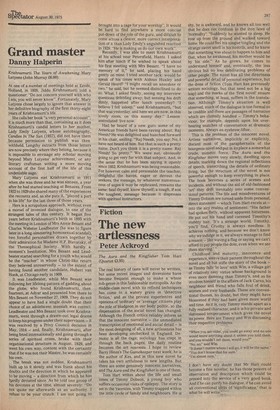Grand master
Danny Halperin
Krishnamurti The Years of Awakening Mary Lutyens (John Murray £6.00) At one of a number of meetings held at Eerde, Holland, in 1928, Jiddu Krishnamurti told a questioner: "Do not concern yourself with who I am; you will never know". Fortunately, Mary Lutyens chose largely to ignore that answer in her definitive biography of the first thirty-eight years of Krishnamurti's life.
She calls her book "a very personal account"; it is much more than that, containing as it does Krishnamurti's candid letters to her mother, Lady Emily Lutyens, whose autobiography, Candles In The Sun (1957), did not have them because permission to publish was then withheld. Lengthy extracts from those letters are now precisely where they belong, because it is impossible to envisage any scholar moving beyond Mary Lutyens' achievement, or any literary craftsman writing a more moving account of the first half of the life of this undeniable sage.
Mary Lutyens met Krishnamurti in 1911 when she was three and he was sixteen, a year after he had started teaching at Ben ares. From 1922 to 1929 she shared many of the experiences she recounts and, as she puts it, "played a part in his life" for the last three of those years.
Hers is a scrupulous approach, without even a morsel of invented dialogue, to one of the strangest tales of this century. It began five years before Krishnamurti's birth in 1895 with the meeting in London of Mrs Annie Besant and Charles Webster Leadbeater (he was to figure later in a long-simmering homosexual scandal), two forceful personalities drawn together by their admiration for Madame H.P. Blavatsky, of the Theosophical Society. With hardly a moment's hestitation, Mrs Besant and Leadbeater started searching for a youth who would be the "teacher" in whose Christ-like return they believed unreservedly — to the extent of having found another candidate, Hubert van Hook, at Chicago early in 1909.
It was Leadbeater, while Mrs Besant was following her lifelong pattern of gadding about the globe, who found Krishnamurti, then fourteen, at Adyar and presented him there to Mrs Besant on November 27, 1909. They do not appear to have had a single doubt that their choice of an adolelscent messiah was correct. Leadbeater and Mrs Besant took over Krishnamurti, went through a drawn-out legal drama to keep his progress under their supervision — it was resolved by a Privy Council decision in May, 1914 — and, finally, Krishnamurti, after being feted internationally and going through a series of spiritual crises, broke with their organisational structure in August, 1929, and went his own way, content with the certainty that if he was not their Master, he was certainly his own.
The break was not sudden. Krishnamurti built up to it slowly and was frank about his doubts and the direction in which he 4ipeared to be moving — a direction from which he has hardly deviated since. As he told one group of his devotees at the time, almost severely: "Do not quote me afterwards as an authority. I refuse to be your crutch. I am not going to brought into a cage for your worship". It would be hard to find anywhere a more concise put-down of the.role of the guru, and dificult to come across a clearer, more correct interpretation of it than Lady Emily's anguished reaction in 1928: "He is making us do our own work". Recently, I was able to meet Krishnamurti at his school near Petersfield, Hants. I asked him after lunch if he wished to speak about his first meeting with Mrs Besant. "I have no memory of it," he said, placing his hand gently on mine. I tried another tack: would he speak of his times with Aldous Huxley and Gerald Heard? "I might recall an anecdote or two," he said, but he seemed disinclined to do so. What, I asked finally, seeing my interview questions dribbling away, but sensing his drift dimly, happened after lunch yesterday? "I believe I fell asleep," said Krishnamurti, "but that was yesterday, and here we are now, in this lovely room, on this sunny day." Lesson assimilated: live now.
Had he heard of a new guru some of my American friends have been raving about: Raj Neesh? He was delighted and hunched forward in his chair, smiling. "Raj Neesh, you say. No, I have not heard of him. But that is such a pretty name. Don't you think it is a pretty name: Raj Neesh! So pretty." We were not, obviously going to get very far with that subject. And, in the sense that he has been saying it openly since 1932, Krishnamurti was being reasonable. For however calm and personable the teacher, delightful the haven, eager or devout the seekers, the message, by whatever numerousness of sages it may be rephrased, remains the same: heal thyself, know thyself; a tough, if not the toughest, message because it dispenses with spiritual instructors.


































 Previous page
Previous page